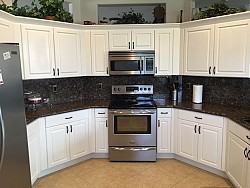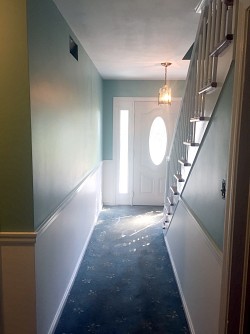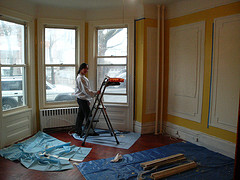Paint a Room or Two in a Weekend
Interior painting is perhaps the most satisfying of all home decorating projects. It allows you to reap rich rewards -- a fresher look and an unmistakable upgrade in style -- for a relatively small outlay of cash and time. In fact, it is entirely possible to paint a room or two of your home from start to finish in just one weekend. Here we present 19 tips designed to make the job easier.
- Get organized ahead of time. Make sure you have all the supplies and equipment you'll need:
- Trisodium phosphate (TSP)
- Patching compound and putty knife
- Paint, preferably no- or low-VOC
- Stir sticks
- Rollers, roller covers, and paint trays
- Tapered brushes or paint pads
- Drop cloths
- Ladder or extension pole
- Painting clothes, gloves, hair protection, dust mask, goggles
- Plastic bags
- Bucket and paint comb for cleanup
- Carefully measure the walls and ceilings you plan on covering to ensure you buy enough paint. Calculate 1 gallon per 350-400 square feet for each coat. If you're planning to paint a room or two, using two coats, you'll need 1-2 gallons depending on room sizes. Better to buy too much than to run out in the middle of the job. Not only would that slow you down, but you also might end up finishing your work with a new can of paint that doesn't quite match the first. Leftover paint may be stored for future touchups.
- Purchase good quality paint for easier, smoother painting and better coverage. It also means that your DIY paint job will look good longer.
- Remove furniture from the room if at all possible. Move large pieces to the center of the room and cover them with plastic.
- Prepare your cleaning setup before you begin to paint. Clear out a sink or get your garden hose ready. Make sure you have a bucket and a paint comb available for cleaning brushes and rollers.
- Patch holes or cracks in your walls and around trim with patching compound and a putty knife. Sand with fine grit once the compound has dried. Make sure you clear up any dust.
- Wash the walls so paint will adhere properly. Use TSP as your cleaning agent to remove greasy, waxy, or sticky stains and to etch the woodwork, which will also help the paint to stick. Also, vacuum your floor, baseboards, and other dusty surfaces.
- Take down items such as light fixtures, outlet covers, and switch plates.
- Prime new or patched walls. You can also save time when you want to cover a light wall color with a darker one by applying primer in a shade close to your intended finished product.
- Start by painting the ceiling, then do the trim for the cleanest-looking results.
- Keep a moist sponge or rag close by to wipe up any painting "mistakes" ASAP.
- Cut in your topcoat color, using a tapered brush or paint pad for fast neat edges.
- Start with a moistened roller. Then roll the wall paint in "w" shapes for the evenest coverage.
- Finish each wall completely before you move on to the next.
- Remember the first coat does NOT have to be perfect -- it will be covered soon enough. Do tidy up drips, though.
- Cover rollers and brushes tightly with plastic bags in between coats. They will stay moist and ready for the next painting session.
- Allow at least 2 hours drying time (or more, according to paint manufacturer's instructions) between coats. This is one area where you definitely do not want to rush.
- Clean brushes and rollers correctly when you're finished with your final coat. Remove alkyd paint with solvent, followed by a thorough wash in soapy water. For latex, you can skip the solvent. Rinse well and hang upside down to dry.
- Check out your local regulations regarding safe disposal of unused paint.
Find professional painting contractors near you.
Laura Firszt writes for networx.com.
Updated October 10, 2018.
Looking for a Pro? Call us (866) 441-6648

Painting Average Costs
Painters Experiences

Painting My Stem Wall Took Half A Day Of Meticulous Work

Repainting Our Kitchen Cabinets Was A Small Fix With Big Impact

Interior Painting And Repairs Restore The Home I Bought At Auction
Top Cities Covered by our Painters
Austin
| Boston
| Charlotte
| Chicago
| Columbus
| Dallas
| Denver
| Detroit
| El Paso
| Fort Worth
| Houston
| Indianapolis
| Jacksonville
| Los Angeles
| Nashville
| New York
| Philadelphia
| Phoenix
| Portland
| San Antonio
| San Diego
| San Francisco
| San Jose
| Seattle
| Washington



